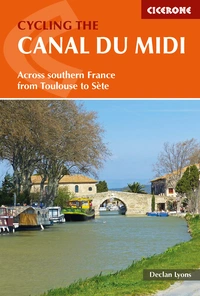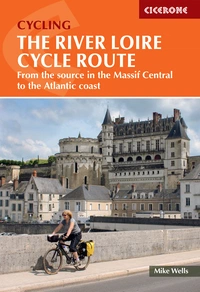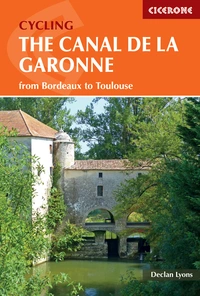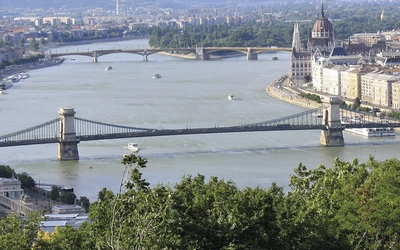5 great days out along the Canal du Midi cycle route
Cycling the Canal du Midi makes for a wonderful and not too difficult tour from Toulouse to Sète in France. The 260km route can easily be cycled in a week although it is worth having a few extra days so you can spend some time being a tourist à pied. Here are 5 great days out along the Canal du Midi cycle route.
Cycling the Canal du Midi
Across Southern France from Toulouse to Sete
£14.95
Guide to cycling the Canal du Midi in southern France, 240km from Toulouse in the Haute Garonne to Sete on the Mediterranean Coast. The flat, picturesque route is divided into five stages, each around 50km long. Includes detours to sights close to the canal as well as longer excursions, including Narbonne, Minerve, Carcassone and Beziers.
More informationMeandering through the lush countryside of southern Languedoc, the Canal du Midi is a popular canal-side cycle route visiting a string of historic towns and villages, bursting with life and culture. The 260km route from Toulouse to Sète is often completed in 5 stages, and offers relatively flat, easy, traffic-free cycling. The route can easily be cycled within a week and is suitable for year-round cycling.
Our guidebook describes the route and its alternatives in detail, and includes information on the history of this UNESCO World Heritage Site, its Roman remains, Cathar castles, medieval monasteries as well as its vineyards visited on the route. Detours to sights close to the canal as well as longer excursions are detailed too, including Narbonne, Minerve, Carcassone and Beziers, the best of which are detailed below.

1. Toulouse
Toulouse, known as the "Rose City" for its red brick buildings, is vibrant and lively, with bustling streets and squares filled with conversation, markets, and buskers. The Canal du Midi starts at Les Ponts Jumeaux, where three bridges cross the canals du Midi, Latéral, and Brienne. Spend at least a day sightseeing, as the city features beautiful houses from the 15th to 17th centuries, and is ideal for exploring by bike or on foot.
Toulouse is a cycling city with extensive cycle lanes, tracks, parking, and bike hire options. Cycle tracks run alongside the Garonne River, canals, and roads, with lanes often shared with buses or running against car traffic. A cycle route map is available at www.toulouse.fr. The River Garonne is lined with parks, public spaces, and south-facing cafés. The Pont Neuf offers the best traditional view of the river.
Notable churches include Basilique St Sernin, built on the site of an earlier basilica housing St Sernin's remains. St Sernin, martyred in AD 250, is commemorated in this 115m-long church, a major medieval pilgrimage stop. Key features are its multi-tiered bell tower, beautiful doors, and extraordinary interior.
Other attractions include the Augustins museum (21 Rue de Metz) with early Christian artefacts, and the St Raymond museum (Place St Sernin) with art and archaeology from early centuries to the Middle Ages. Specialist museums include the natural history museum (35 Allées Jules Guesde), the Museum of the History of Medicine (2 Rue Viguerie – Pont Neuf), and the Space City Theme Park (Avenue Jean Gonord BP25855). Les Abattoirs (76 Allées Charles de Fitte) houses modern and contemporary art.

2. Avignonet Laragais
This well-preserved historic town, notable for its role in the war against the Cathars, is worth visiting.
The church of Notre Dame-des-Miracles, located in Place d’Eglise at the town’s center, was built between the 14th and 16th centuries on the site of an older church. Its polygonal bell tower, over 40m high, dominates the Lauragais Plain. The church is named after a statue found at the original church site and has a plaque commemorating murdered inquisitors.
The town features several other attractions. 16th-century mansions belonged to merchants who made their fortunes producing pastel from the woad plant, yielding a deep blue dye that funded the development of Toulouse and surrounding towns. The main street has an old market building, a stone tower, a statue of a crusader (with a water tap beside it), and a statue of Joan of Arc.

3. Carcassonne
Exploring Carcassonne takes a day. First-time visitors should stay overnight to see the Cité lit up. The Bastille night fireworks on 14 July are among the best in France, so book summer accommodation in advance.
Carcassonne has two parts: the lower town (Bastide St Louis) and the Cité (the ancient walled town). The lower town offers the best value for restaurants and hotels, while the Cité is the main tourist attraction.
The lower town, designed on a grid, has Place Carnot as its main square, lined with cafés, restaurants, and regular markets. Key sights include the cathedral (St Michel), St Vincent’s church, and the Jacobins gate. Climb St Vincent’s bell tower for views over the town and countryside. Belle Epoque architecture is scattered throughout the town. Cycling to the Cité (2km) offers the best views from the Pont Vieux (old bridge).
In the Cité, visit the Château Comtal, Basilique St Nazaire, the walls, battlements, and medieval streets. The château, a fort within the town’s fortifications, offers tours with great views and houses sculptures, including a 14th-century statue of the smiling Madonna. The château also hosts summer concerts, operas, and modern art exhibitions; book early for popular events.

Bonus: The Nine Locks
The ‘nine’ Fonsérannes locks are the most dramatic works on the canal system, and enable the canal to drop 22m and join the Orb river. Boats crossed the river and then rejoined the canal. An aqueduct, built in 1855, obviated the need for the river crossing.
The locks form a water staircase for barges. It is well worth stopping and watching boats ascend and descend. The locks operate in the morning and afternoon with a break between 12pm and 2pm. There is a mechanical lifting system on the southern bank of the canal (no longer in use). The buildings on each side of the canal originally housed canal workers. There is a church too. Although still referred to as the ‘nine’ locks, there are only eight locks now. In addition, the seventh lock is a basin that leads to the aqueduct that crosses the Orb. The eighth lock is no longer used as it leads to a branch of the canal that served Béziers.

4. Castelnaudary
Castelnaudary is easy to explore on bike or on foot. The key tourist attractions are the Collégiale St-Michel, dating from the 13th century with a bell tower with 35 bells; the 18th-century Chapelle Notre Dame de Pitié; and Cugarel’s mill, which has now been restored. There are plenty of shops, restaurants, hotels and services such as pharmacies, doctors and a hospital. Castelnaudary’s port is also well worth exploring, with shops, old warehouses and wine emporia on its northern quay.
The regional dish, cassoulet, is one of the town’s main claims to fame. Legend has it that the townspeople devised this stew while under siege from the English army during the Hundred Years’ War (1337–1453). Along with haricot beans, the key ingredient, cassoulet typically includes confits de canard, pork, sausages and just about anything edible to hand. All restaurants offer their own cassoulet – each chef has his or her own version – and you can buy it canned or in jars.

5. Narbonne
A real gem, Narbonne offers attractions for all tastes.
Charles Trenet (1913–2001), famous for "La Mer" and "Que reste-t-il de nos amours" ("I Wish You Love"), drew inspiration from Narbonne. His birthplace, now a museum (13 Avenue Charles Trenet), showcases early song drafts and artefacts. A large mural of Trenet is near the railway tracks west of the canal.
The 13th-century, unfinished cathedral of Sts Just and Saveur features striking buttresses, gargoyles, and stained glass windows. Nearby are the cloisters, Jardin des Archevêques, and the Palais des Archevêques, which houses a Roman artefact museum and the second-largest collection of religious objects in France. The 13th-century donjon Gilles-Aycelin is also notable.
In the town center, the canal passes under houses, visible from Cours de la République and Pont de la Liberté. Narbonne also has a daily covered market and a renowned open-air market on Sunday and Thursday mornings near the Liberté Bridge.
Cycling the Canal du Midi
Across Southern France from Toulouse to Sete
£14.95
Guide to cycling the Canal du Midi in southern France, 240km from Toulouse in the Haute Garonne to Sete on the Mediterranean Coast. The flat, picturesque route is divided into five stages, each around 50km long. Includes detours to sights close to the canal as well as longer excursions, including Narbonne, Minerve, Carcassone and Beziers.
More information












